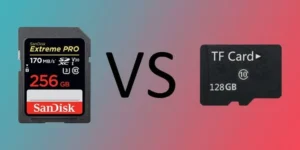Hey there, fellow Windows enthusiasts! Today, we’re going to dive into a topic that’s essential for anyone dealing with digital storage – TF cards and SD cards. We’ll explore the key differences between these two memory card formats, and I’ll share some personal insights on when and why you might prefer one over the other. So, grab your cup of coffee, settle in, and let’s get started!
Understanding the Basics
Before we delve into the nitty-gritty details, let’s make sure we’re on the same page about what TF and SD cards are.
TF Card (MicroSD Card): TF stands for “TransFlash,” but it’s commonly referred to as a MicroSD card. These tiny wonders are the go-to choice for expanding the storage capacity of various devices like smartphones, cameras, and even Raspberry Pi boards.
SD Card (Secure Digital Card): SD cards come in different sizes, including the standard SD, miniSD, and MicroSD variants. They are widely used in cameras, laptops, game consoles, and more.
Now, let’s explore some crucial aspects that will help you decide which card is right for your needs.
Storage Capacity
When it comes to storage capacity, SD cards often come in larger sizes compared to TF cards. SD cards can offer capacities ranging from a few gigabytes to a whopping terabyte! This makes them a solid choice for photographers and videographers who require ample storage for high-resolution media files.
On the other hand, TF cards are more compact and are generally available in smaller capacities, making them suitable for devices with limited space, like smartphones and compact cameras. However, you can still find MicroSD cards with impressive storage capacities, so don’t underestimate their potential.
Compatibility
Compatibility is a crucial factor to consider. Most modern devices support both TF and SD cards, but it’s essential to check your device’s specifications before making a purchase.
SD cards are favored for their versatility. You can use them with an adapter to fit into a MicroSD slot, making them compatible with a wide range of devices. TF cards, on the other hand, have a smaller form factor, so they might not work without an adapter in some cases.
Speed and Performance
The speed of your memory card can significantly impact your device’s performance, especially if you’re using it for tasks like recording 4K videos or gaming.
SD cards typically offer faster read and write speeds, making them ideal for demanding applications. High-quality SD cards are designed to handle data-intensive tasks smoothly, ensuring that you don’t experience lag or dropped frames while shooting videos or playing games.
TF cards, while capable of decent speeds, may not always match the performance of their SD counterparts. If you’re working with high-definition media or require fast data transfers, an SD card might be the better choice.
Price Point
Now, let’s talk budget. TF cards often come at a more budget-friendly price point compared to SD cards with similar specifications. This makes them a great choice for anyone looking to expand their device’s storage without breaking the bank.
However, if you demand top-notch performance and require high-capacity storage, you might need to loosen your purse strings for an SD card. The price difference is usually justified by the superior speed and capacity they offer.
Personal Recommendations
As a Windows expert who’s been around the block a few times, I’ll offer some personal recommendations:
- If you’re a casual user looking to expand your smartphone or tablet storage, a TF (MicroSD) card should suffice. Just ensure it’s compatible with your device, and you’ll enjoy extra space for photos, apps, and music.
- Photographers and videographers who deal with large media files should invest in high-quality SD cards with ample storage and fast read/write speeds. This will ensure smooth shooting and reliable storage.
- Gamers and power users seeking faster load times and seamless gameplay should opt for SD cards with fast data transfer rates. This can significantly enhance your gaming experience.
Conclusion
In the TF card vs. SD card showdown, there’s no one-size-fits-all answer. Your choice should be tailored to your specific needs and budget. Remember to consider storage capacity, compatibility, speed, and pricing when making your decision.
Before you rush out to buy a new memory card, check your device’s specifications and think about how you plan to use it. Whether you opt for a tiny TF card or a beefy SD card, you’ll be well-equipped to handle your digital storage needs. Happy storing, Windows aficionados!
And if you want to explore more about these memory cards or find some great deals, don’t hesitate to visit some reputable online retailers like Amazon or Best Buy for an extensive selection. They often have detailed product descriptions and customer reviews to help you make an informed decision.
Also Look at this Article






